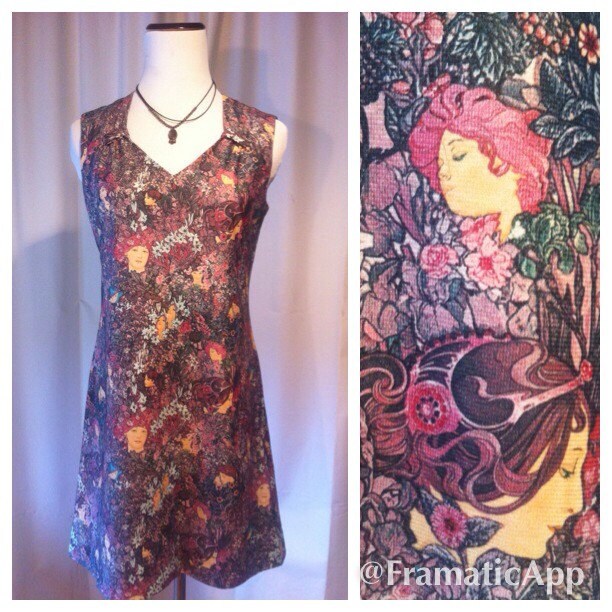The Art Nouveau time period started in the late 1880s and lasted until about 1915. It was largely influenced by a call back to nature. Architecture to art to jewelry were all by products of this trend. It is often characterized by large, ornate scrolling, muted colors, nymph or fairy-like dramatization of the female form, flowers, butterflies and dragon flies, and even arched doorways and decorative molding in architecture. An immediate example of this can be seen in stained glass Tiffany lamps. These are some other examples of its influence:
There was some revival to this style in the very early 1970s with the rise of the bohemian (boho) movement. Concert posters relied heavily on this style.
I recently sold a dress that was made during this later time period. The fabric and style are a wonderful representation of how these two time periods influenced each other. More pictures can be seen here.
Often, Art Nouveau and Art Deco are interchanged. I think it is most likely due to their close proximity in time frames. There is a very stark difference between the two as you will see below.
Art Deco
Art Deco arose with the rise in industrialization at about the time of World War I (1914). Where Art Nouveau was influenced by nature, Art Deco was influenced by the Industrial Age and lasted until the early to mid 1940s. It can be characterized by its bold streamlined stacked and cascading geometric shapes, rich colors, and its celebration of luxury with uses of stainless steel and chrome. Again, influences can be seen in architecture, art, jewelry, clothing, and anything else from this time period. Prime examples are seen in the Chrysler and Empire State buildings in New York City.
More examples can be seen in other items from this time period.
In art and fashion, where Art Nouveau rounded a woman's figure, Art Deco narrowed and elongated the female form. Hem lines rose and waist lines dropped. Corsets and petticoats were out and were replaced by under slips, camisoles, tap pants, and a combo cami/tap pant called a 'step in'.
Ford had produced his Model T, and for the first time in history, people were on the go like never before. It was a time period vastly different from its predecessor just a decade earlier. Egypt and the rest of the world saw the opening of King Tut's tomb in 1922. Fashion celebrated in what is termed as The Egyptian Revival with elaborate beading and Egyptian motifs.
Elaborate lifestyles and excess, despite Prohibition (1920-1933), were admired as this was an age where anything seemed possible. The Jazz Age was formed, a risqué new form of music. No one saw more liberation during this time period more than women. The 19th Amendment to the Constitution gave them the right to vote in 1920. It was certainly a time to celebrate! They don't call it "The Roaring '20s" for anything less than what it was!
Women took more personal freedoms with the most revealing clothing to date and short 'bob' hairstyles. The 1920s silhouette was a simple one, but this time period is known for its elaborate embellishments such as beading, appliques, and softly layered fabrics such as silk chiffon and satin.
This most prosperous time lasted up until Black Tuesday in 1929 which threw the economy and the US into turmoil, to such an extent that it has never been forgotten. This is where I will pick up in the next segment.





No comments:
Post a Comment